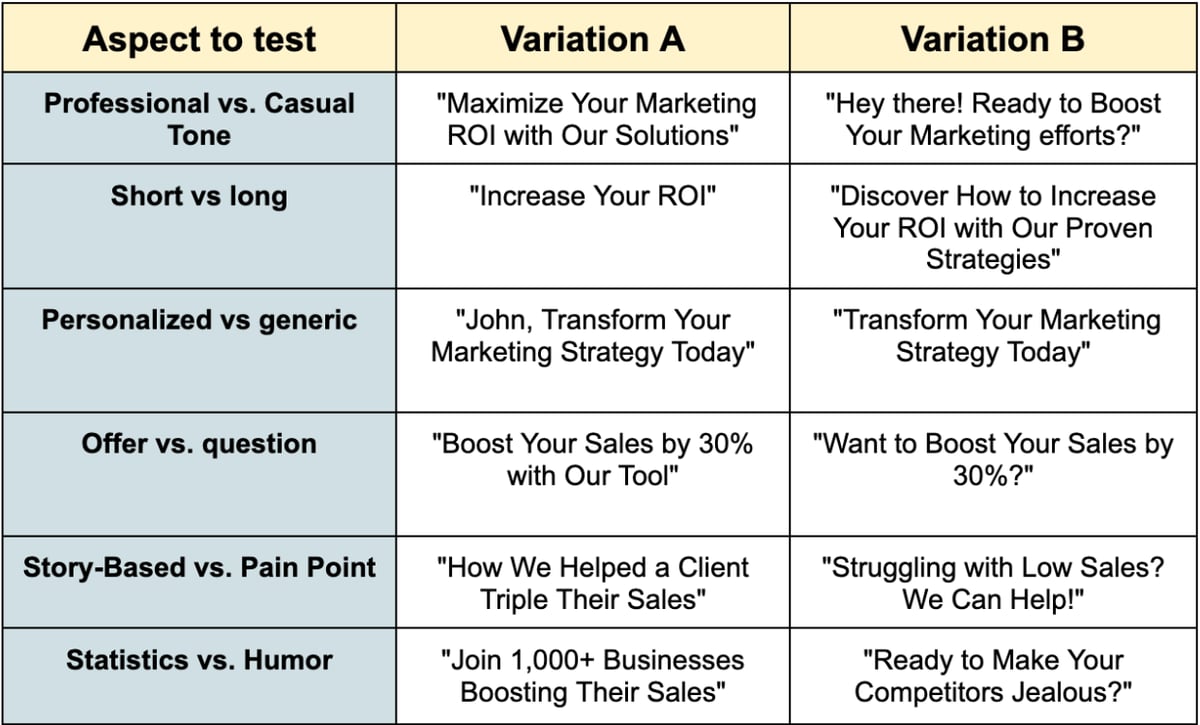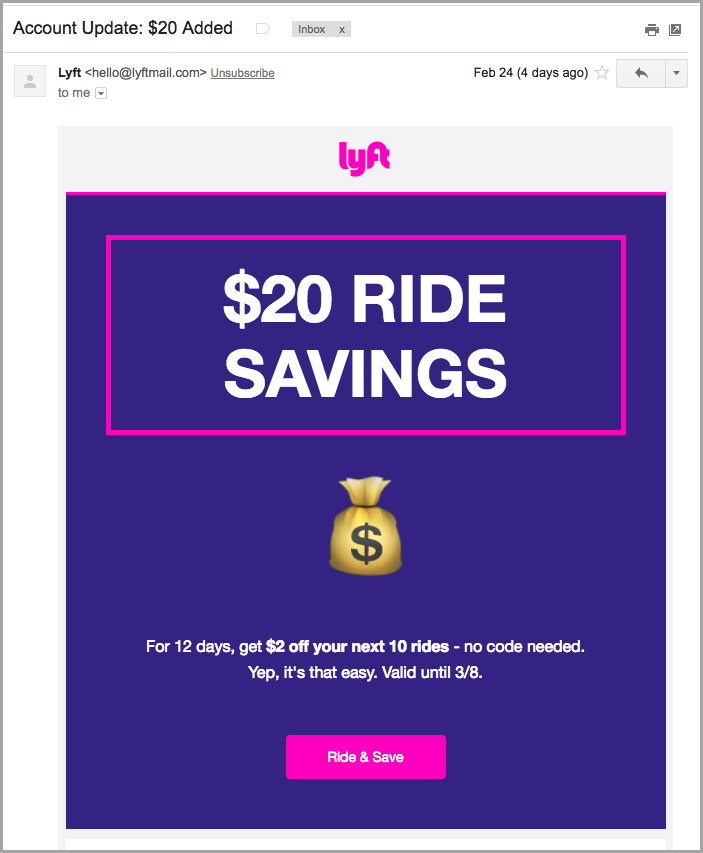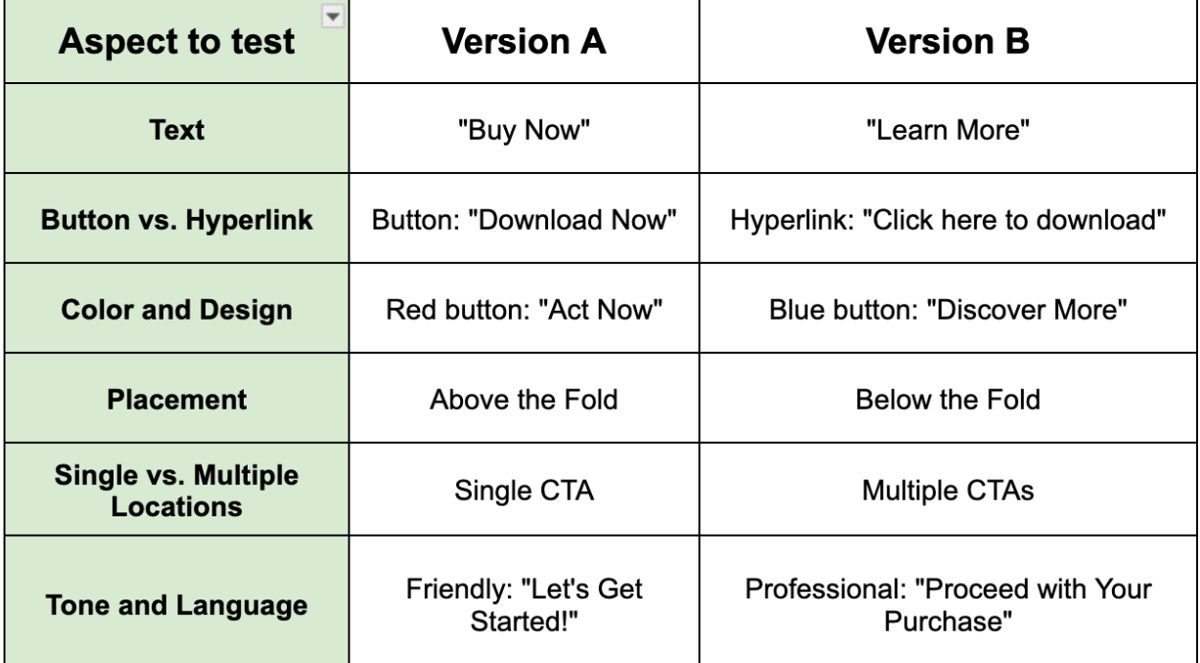Why A/B Test and How It’s Important?
To make cold emailing work, you must figure out an approach first. A/B testing can make your cold email campaign more effective. It lets you compare two email versions to see which one performs better.
Don't just guess what might catch the attention of a recipient. You can use metrics like open rates, click-through rates, and conversions to decide what your recipient might react to or what will make them open your email. This will ensure your messages are opened, read, and responded to.
This approach has been shown to boost engagement and response rates significantly. For example, testing different subject lines can increase your open rates significantly, as 47% of email recipients open an email based on the subject line.
What Should You Test in Your Cold Emails?
To get the most out of A/B testing, it's important to test different parts of your cold emails. Some important parts to look at are:
- Subject lines.
The subject line catches the recipient's eye and helps them decide whether to open your email. Around 69% of email recipients will mark an email as spam based on the subject line. Consider what you include in your subject line, including ways to make it more attention-grabbing and how long it should be. These are the factors that determine whether your email gets opened or not. Using subject line testers can also help you analyze and adjust the impact of specific words or phrases, maximizing open rates and minimizing the risk of your emails landing in the spam folder.
- Content.
After your email gets opened, the content keeps a reader interested. It might be your friendly tone, how you structure your message, or how personal it feels—each part of your email content matters. By experimenting with your tones, adding personal touches, and even adding some fun GIFs or pictures using ai video maker, you can get people excited to take action. To ensure your emails reach your recipient’s inbox and stay out of spam, you can integrate EmailLabs deliverability features. You can also use a free DMARC checker to verify your domain’s authentication and further improve deliverability.
- Call-to-Action (CTA).
Now's your chance to tell the reader what to do after reading your email. You can ask them to schedule a meeting, download something, visit your website, or try your product or service. This part of your email is important because it guides the reader to do what you want them to do. Experimenting with various calls-to-action (CTAs) can significantly increase open rates and improve other metrics. Research conducted by HubSpot showed that personalized CTAs outperform basic CTAs by an impressive 202%.

Image source: HubSpot.com
- Sender's name.
What's the first thing you see in an email? According to the Litmus-Fluent survey, a sender's name is the first thing people look at. If they recognize the sender, they're more likely to open it. You can try using a person's name instead of a company's name or mix and match to see what works best. This can make your email feel more personal and trustworthy.

Image source: Litmus.com
Establish Your Goals and Metrics to Track
Now, when starting an A/B test, you need to know what results you want to get. When you know exactly what you want to achieve with your cold emails, you can measure their success. Here are some common goals you might consider:
- Open rates: This is the percentage of recipients who open your email. A higher open rate indicates that your subject line and sender name are interesting enough for recipients to open your email.
- Click-through rates (CTR): This is the percentage of recipients who click on links within your email. A high CTR means your content is engaging and your call-to-action (CTA) is effective.
- Conversion rates: The conversion rate shows how many people who receive your email take the action you want them to. It may be filling out a form, signing up for a webinar, or purchasing. A high conversion rate means your email grabs attention and gets people to do what you want, which can be effectively monitored using referral tracking software.
Additional Metrics to Consider:
- Bounce rates: The percentage of emails that couldn't be delivered to the recipient's inbox. High bounce rates can indicate issues with your email list quality. Also, a common issue can be that the addresses are wrong, try using a LinkedIn email finder tool to ensure that you have all the right ones and decrease the bounce rate.
- Unsubscribe rates: This is the percentage of recipients who stop receiving your future emails. Keeping an eye on this metric helps you understand when you have to change your approach.
- Reply rates: Reply rates show how many people responded to your email. If your reply rates are low, it could mean that your subject line isn't catchy enough to get people to open your email. People might not feel curious or interested enough to read what you've sent without an attention-grabbing subject line.
II. Prepare for the Test
Create Variations for Each Element Being Tested
The main goal is to test different versions of an email, but it doesn't necessarily mean that you have to change the whole email. Start experimenting with different parts of an email:
- Subject line
Start with the subject line first, as it is one of the things that readers look at when deciding whether to open an email. Try creating multiple subject line variations, each focusing on a different aspect.
Examples:

Testing these aspects lets you find which option works best for your audience. There are many things to be aware of if you want to maximize the results:
- Create a sense of urgency ( FOMO) in the subject line, urging the reader to open the email.
- Be personal. A personalized subject line can increase your average open rate by 7.4%. You can personalize subject lines using details like birthdays, previous purchases, and the customer’s location.
- Use gifts. Everybody loves gifts, but the issue is that usually words like “free,” “discount,” and “cheap” will end up in a spam box. So try using other words for it, like in this example of Lyft. The company doesn't say "Free Gift." Instead, it tells customers that they have $20 in their accounts.

2. Content
Now, let’s talk about the heart of our emails: the content. It's where we connect with our audience on a deeper level and can make them take action. Here are some aspects of content you can test:
- Tone.
Think of your content tone as chatting with a friend. Testing a friendly, conversational tone against a more formal one can help you find the right vibe that matches your audience.
- Messaging.
The way you deliver a message matters. You can go straight to the point or tell a story to make it more interesting. See what works best to grab your audience's attention.
- Formatting.
Ever heard the saying "less is more"? Testing different formatting styles, like bullet points or longer paragraphs, can help you find that perfect balance.
- Visuals.
A picture's worth a thousand words, right? Testing emails with eye-catching visuals can help get attention. They also make your message easier to remember than emails with only text. Videos created via a free ai video generator can also make your message more eye-catching. The Benchmarks report found that emails with images got an open rate of 30.27% and a CTR of 2.78%.
- Personalization.
A personal touch can make a big difference. Try using personalized content, which is tailored to your recipient's interests or past interactions. You might see an increase in engagement.
3. Call-to-Action (CTA)
The CTA is where you encourage your readers to take the desired action, whether it's making a purchase, signing up for a webinar, or downloading a guide. Here are some variations to test:

Testing these will help you see which ones work best for your target audience. However, here are some of the tips to bear in mind when choosing the right CTA:
1. Use Action-Oriented Language
CTAs should tell the reader what action to take. Action verbs (like “get,” “join,” “claim,” “download,” etc.) create a sense of urgency and directness. Some of the examples:
- "Get Started Now"
- "Download Your Free Guide"
- "Join the Webinar"
- "Claim Your Discount"
2. Create a Sense of Urgency
Urgency can prompt immediate action, reducing procrastination. Phrases that suggest limited time or availability work well:
- "Limited Time Offer - Act Now!"
- "Only 3 Days Left!"
- "Register Today - Seats Filling Fast"
- "Hurry, Offer Ends Soon"
3. Test Different Designs
Color, size, and shape can affect how well your CTA performs. Usually, bold colors that stand out and put the CTA in a noticeable spot can make a big difference. Also:
- Use bright colors like red, green, or orange for buttons. However, according to a CXL research of multiple case studies, the red CTA button always seems to work better than the green one.
- Ensure the CTA button is big enough for people to click on it easily.
- Put the CTA where people can easily see it, like at the top of the email, before they have to scroll, or have it appear at the top and bottom.
- Include attachments or links to your business proposals.
4. Personalize the CTA
As mentioned earlier in the article, according to a HubSpot study, personalized CTAs can increase engagement by 202%. So make sure to make it as personal as possible, like:
- "John, Start Your Free Trial Now"
- "Get Your Customized Plan"
- "Find Your Perfect Solution"
- "Join Our Community Today, Jane"
Get everything ready to start the test
When you have figured out what aspects of an email you are going to test and crafted the copies, you are one step away from launching the test. If you want to actually see results that will give fruitful insights, you should also do the following:
- Split Your Email List Evenly
Break your list into smaller groups of about the same size and randomly chosen. This ensures that each group gets a different email version under similar circumstances.
- Ensure Large Enough Groups
If you want reliable data, try to have at least 100 people in each group. The bigger the groups, the more you can trust the information.
- Send Test Emails At The Same Time
Send your test emails at the same time each day to avoid problems. The best time to send emails is usually mid-morning or mid-afternoon. However, this can change depending on your audience.
III. Analyze the Results and Implement the Results
Once you've sent your test emails, it's time to dive into the data. Keep your eyes on Open Rates, Click-Through Rates, and Reply Rates for each version of your email. These measurements show you what is working and what isn't.
To understand all this data, you'll need guidance from your go-to marketing analytics experts and helpful tools like Google Analytics, Mailchimp, HubSpot, and Mixpanel that track how well emails are doing.
When you have the numbers, look for patterns and trends. Are there some subject lines that always grab attention? Do certain CTAs lead to more clicks and conversions? What is the open rate of an email with an image?
Once you've reviewed the information, it's time to make choices. Pick the email that fits your goals best. Use the information you learned from your A/B testing in all your email campaigns. This will help you get the best results from your marketing plan.
VI. Conclusion
A/B testing is a fantastic way to make your cold email campaigns more effective. It helps you make smart decisions based on real data to engage your audience better and get more responses.
Remember, A/B testing is a never-ending process. Keep trying new ideas and improving your approach to keep your emails interesting and engaging. Make testing a regular part of your plan. This way, you'll stay ahead and keep seeing better results.







